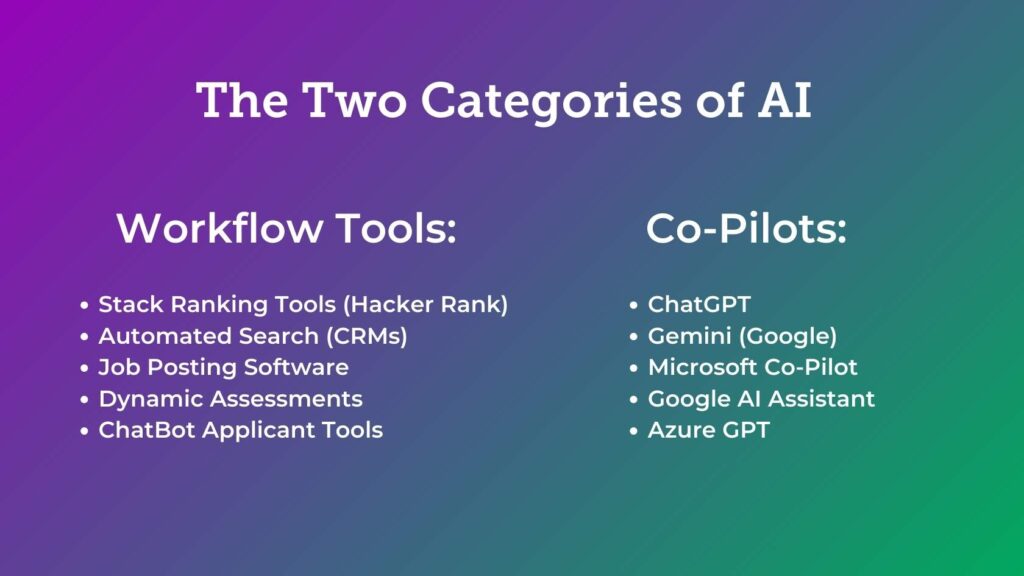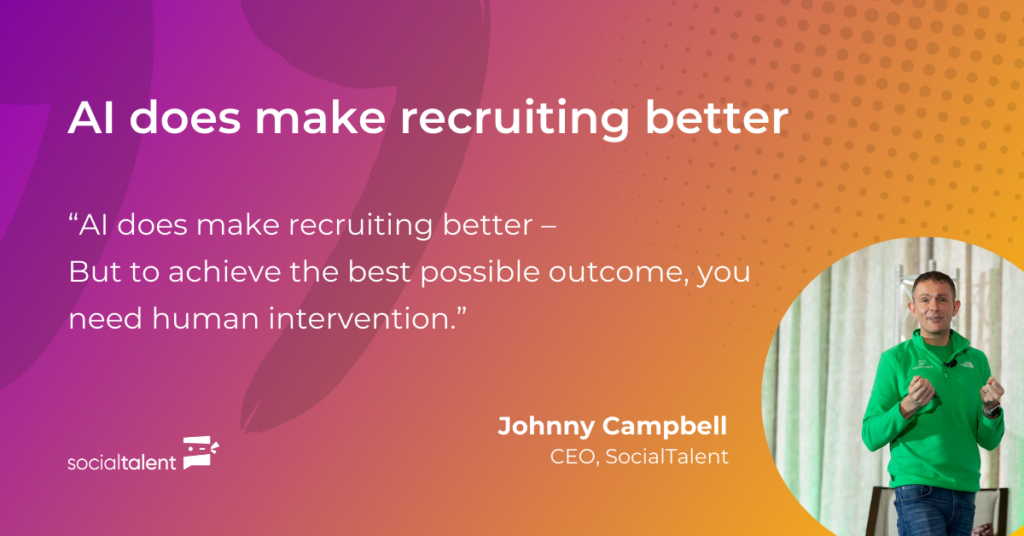All Talk, No Action: Moving Beyond the Hype of AI and Recruiting
I’m a little annoyed about something!
We’ve all heard a lot of buzz recently about AI in recruiting – what it is, what its capabilities are, how it’s going to change the industry. I’ve been to countless conferences and listened to numerous talks, but I’m finding it increasingly frustrating that these discussions often just center on what AI might do, rather than what it is currently doing.
Back in SocialTalent’s early days, when we were starting to teach recruiters how to use the internet to source candidates, I realized something fundamental – people need actionable advice to help solve immediate problems. This same principle should be applied to the current state of AI and recruiting as well.
Theory and speculation is all well and good, but AI is here. No-one can deny that anymore. And at some point we need to move beyond talk and get down to the brass tacks of actually doing.
The Two Categories of AI

First, I think we need clarity over what I mean when I refer to AI in the context of recruiting. There are two main categories:
- Workflow Tools: These include stack ranking tools, automated search tools, CRM systems, and job posting software. These tools are typically procured and implemented by organizations, often taking months to be fully operational.
- Co-Pilots: Tools like ChatGPT, Google’s Gemini, and Microsoft’s Co-Pilot. These are accessible immediately and can be used by individuals regardless of organizational policies.
It’s the latter I want to focus on in this article. I can sense the nervousness around this! But if you think your recruiting teams aren’t using tools like this, think again! Co-Pilot style AI is omnipresent and arbitrary bans won’t hamper its proliferation.
People are finding workarounds or using their own personal devices. And it really begs the question – wouldn’t you rather your team use paid licenses that are controlled by the organization and have secure data privacy in place?
Perhaps that’s a topic in itself for another day! The reality is that this is the AI recruiters need practical guidance on. Why? Because it can supercharge the role.
AI as an Assistant, Not a Replacement
One of my favorite studies on AI and recruiting comes from Harvard Business School. Entitled “Falling Asleep at the Wheel” it investigates the trade-off between AI accuracy and human engagement in hiring.
The research assessed 181 recruiters as they collectively reviewed 8,000 resumes for a software engineer role using various AI tools of varying quality:
- A perfectly predictive AI
- High-performing AI
- Low-performing AI
- No AI (control group)
The findings from the study showed an intriguing trend. While at a base level the recruiters who used AI, in any capacity, performed better, it was the ones with a lower quality model who excelled. Why do you think this was?
Well, with high-level AI recruiters had a tendency to sit back and let the machine take over. As weaker AI is more prone to error it thus meant that experienced recruiters would spend more time questioning results and outcomes.
It’s a fascinating conclusion. AI does make recruiting better, but to achieve the best possible outcome, you need human intervention.
And this is the biggest lesson to take away before we jump into practical application – AI is an assistant, not a replacement for expert recruiting knowledge.
AI in Action
Let me illustrate AI’s current potential through practical examples using ChatGPT. One of the biggest use cases I get asked about is around job specs. In fact, during a presentation at the recent recruiTECH event in Budapest I demonstrated the creation of a job spec with ChatGPT for a Director of Finance role in Audi.
Here’s the full video of how I partnered with AI to complete this task:
Key highlights:
1. Language: I was able to tell the AI to edit the job spec to use ‘you/your’ language over ‘we/I/us’ language because I know this is more attractive to high quality candidates.
2. Diversity: Having more female applicants was a fabricated goal, so I asked ChatGPT to check the job spec for masculine coded words.
3. Research: I got the AI to create a short-list of 20 companies in Hungary where I could find talent applicable to the role. I then had it turn this into a table with pros and cons so I can better understand the strengths and weaknesses of Audi. It even created a Boolean search string for me.
4. Outreach: After finding a prospect, we worked on creating personalized and targeted outreach messages, even workshopping alternatives when some didn’t quite hit the mark.
5. Interview prep: Next, we designed an interview process together and developed a rubric that will help keep alignment on the hiring team so we all know what good looks like and what values are most desired at Audi.
6. Social: We also worked out some social ads we could run to try and attract a younger demographic.

The Human-AI Balance
AI tools can accomplish in minutes what might take hours manually. However, the role of human expertise remains crucial. As can be seen in the video, my experience in this field allowed me to validate and refine AI-generated outputs, ensuring greater accuracy and higher quality.
But the scope is immense.
AI offers huge potential in recruiting, yet its true power lies in its use as an assistant to the knowledgeable talent advisor. So I leave this article with a klaxon to experiment. Push AI to the limits, use your experience and insight as a recruiter to guide this powerful tool and achieve hiring excellence!
